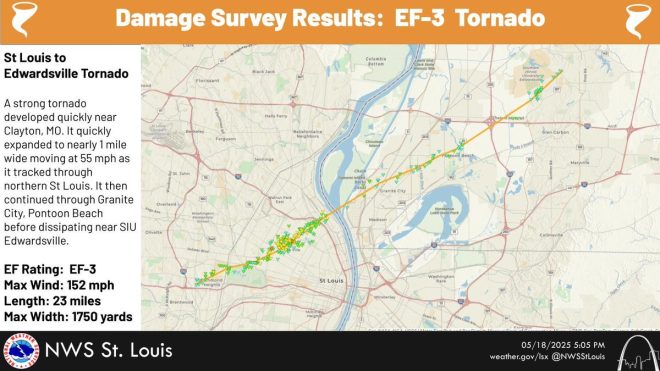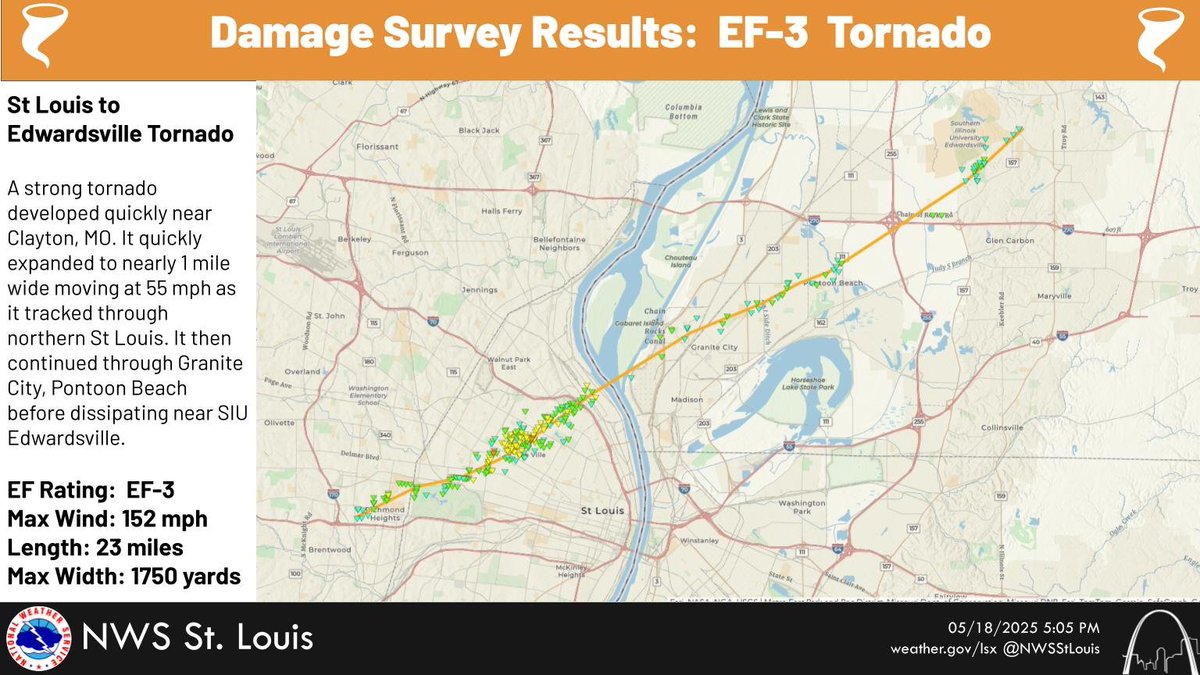
Summary of the St. Louis to Edwardsville Tornado Survey
On May 18, 2025, the National Weather Service (NWS) in St. Louis concluded its tornado survey, revealing critical insights about a significant weather event that affected the region. The tornado, classified as an EF3, reached wind speeds of up to 152 mph, making it one of the more severe tornadoes to impact this area. The tornado tracked northeast through the city at an impressive speed of 55 mph and expanded to a width of up to 1 mile at certain points during its path. The storm eventually lifted near Southern Illinois University Edwardsville (SIU-Edwardsville), marking the end of its destructive journey.
Understanding EF3 Tornadoes
EF3 tornadoes are characterized by their ability to cause considerable damage. According to the Enhanced Fujita Scale, which categorizes tornadoes based on the severity of damage they inflict, an EF3 tornado can uproot trees, severely damage structures, and cause significant debris. Wind speeds in this category range from 136 to 165 mph. The St. Louis to Edwardsville tornado, with its peak winds of 152 mph, exemplifies the destructive potential inherent in such storms.
Tornado Path and Impact
The tornado began its path in St. Louis, quickly moving northeast and impacting various neighborhoods and structures along the way. The speed at which it traveled—55 mph—allowed it to cover ground rapidly, potentially catching residents off guard. The tornado’s ability to expand to a width of 1 mile at times indicates a powerful and broad circulation, which can lead to widespread devastation.
The conclusion of the tornado’s path near SIU-Edwardsville is particularly notable, as this area is home to a large number of students and staff. The proximity of the tornado to populated regions highlights the importance of timely weather alerts and community preparedness in mitigating potential harm.
- YOU MAY ALSO LIKE TO WATCH THIS TRENDING STORY ON YOUTUBE. Waverly Hills Hospital's Horror Story: The Most Haunted Room 502
Circulations and Further Analysis
In the aftermath of the tornado, further analysis is expected to determine whether one or more circulations were present during the storm. This kind of examination is crucial for understanding the dynamics of the tornado and can provide valuable insights for future forecasting and preparedness efforts. Meteorologists and researchers will likely study Doppler radar data, eyewitness accounts, and damage reports to paint a clearer picture of the tornado’s behavior and impact.
Community Response and Preparedness
The occurrence of an EF3 tornado serves as a reminder of the importance of community preparedness in the face of severe weather. Local authorities and emergency management agencies play a crucial role in educating residents on the risks associated with tornadoes and the steps they can take to protect themselves and their families. This includes having a plan in place, knowing the safest locations to seek shelter, and staying informed through local weather updates.
In the wake of the St. Louis to Edwardsville tornado, community resilience will be tested as residents begin the recovery process. Engaging in open communication with local officials and utilizing available resources for disaster recovery can significantly aid communities in bouncing back from such events.
The Role of Technology in Tornado Tracking
Advancements in meteorological technology have improved the ability to track and analyze tornadoes, allowing for better forecasting and warning systems. Doppler radar, for example, plays a critical role in detecting the rotation of storms that may produce tornadoes. The NWS’s prompt survey and analysis of the St. Louis to Edwardsville tornado reflect the importance of utilizing technology to understand and respond to severe weather events effectively.
Conclusion
The St. Louis to Edwardsville tornado of May 18, 2025, stands as a stark reminder of nature’s power and the potential for severe weather to impact communities. With wind speeds reaching up to 152 mph and a path that expanded to 1 mile wide, this EF3 tornado caused significant concern and damage in its wake. The ongoing analysis by the NWS will provide further insights into the event, enhancing our understanding of tornado dynamics and improving future preparedness efforts.
As communities recover, the emphasis on education, preparedness, and the use of technology will be vital in ensuring that residents are equipped to handle future weather challenges. By fostering a culture of awareness and resilience, communities can better protect themselves against the unpredictable forces of nature. The lessons learned from this tornado survey will undoubtedly contribute to more effective strategies in mitigating the impacts of severe storms in the future.

The St Louis to Edwardsville tornado survey has concluded. It was an EF3 tornado with winds up to 152 mph. It tracked northeast through the city at 55 mph, expanding to 1 mile wide at times. It lifted near SIU-Edwardsville. Further analysis may determine one or more circulations. pic.twitter.com/XXAYvKGRBl
— NWS St. Louis (@NWSStLouis) May 18, 2025
The St Louis to Edwardsville Tornado Survey Has Concluded
Tornadoes can be both fascinating and terrifying phenomena, and the recent tornado that tracked from St. Louis to Edwardsville is a prime example of nature’s raw power. According to the National Weather Service, the tornado was classified as an EF3, boasting winds that reached an impressive 152 mph. This level of intensity is significant, as it can cause severe damage to structures and trees, making it essential for communities to prepare and respond effectively.
The survey confirms that this tornado tracked northeast through the city at a speed of 55 mph. That’s fast! Residents and local authorities had to act quickly, and understanding the tornado’s path is crucial for improving future response efforts. The tornado expanded to a width of one mile at times, illustrating just how wide and destructive it could be. Fortunately, it lifted near Southern Illinois University Edwardsville (SIU-Edwardsville), which might have mitigated further destruction.
Understanding EF3 Tornadoes
When we talk about tornadoes, classification is key. The Enhanced Fujita (EF) scale is used to rate the intensity of tornadoes based on the damage they cause. An EF3 tornado, like the one that hit from St. Louis to Edwardsville, can produce winds ranging from 136 to 165 mph. This level of wind can lead to severe damage, including the destruction of well-built homes, uprooting of trees, and flipping cars.
In essence, an EF3 tornado has the potential to wreak havoc, and understanding its capabilities can help communities develop better preparedness plans. The recent tornado serves as a reminder that even areas accustomed to severe weather must remain vigilant and ready to respond to such events.
Tracking the Tornado’s Path
The tornado tracked northeast through St. Louis at 55 mph, which is quite fast for a tornado. As it moved, it expanded to a mile in width at times, leaving a path of destruction in its wake. The tracking speed and width of the tornado are critical pieces of information for meteorologists and emergency management officials.
Fast-moving tornadoes can be particularly dangerous because they leave little time for warnings. Residents in the impacted areas need to have a plan in place for such rapid events. Understanding how tornadoes move and develop can help communities enhance their safety measures.
The Community’s Response
In the wake of the St. Louis to Edwardsville tornado, community responses are pivotal. Local emergency services, volunteers, and residents must come together to assess the damage and provide assistance to those affected. The National Weather Service’s announcement about the tornado’s classification and path is a vital part of this process, as it helps inform planning and recovery efforts.
Communities can benefit from understanding how to prepare for tornadoes and what to do in the aftermath. This includes having emergency kits, knowing safe locations in homes or buildings, and being aware of local warning systems. The recent tornado events highlight the significance of community preparedness and resilience.
Further Analysis May Determine One or More Circulations
The phrase “further analysis may determine one or more circulations” indicates that meteorologists will continue to study the storm. This kind of analysis is essential for two primary reasons: first, it helps understand the tornado’s behavior for future reference, and second, it can provide insights into how to better prepare for similar weather events.
Circulations refer to the rotating winds within a storm that can lead to tornado formation. Identifying these circulations allows meteorologists to improve their forecasting models and provide more accurate warnings in the future. The research process is critical for advancing our understanding of tornadoes and enhancing public safety.
Protecting Your Home and Family
As we reflect on the St. Louis to Edwardsville tornado, it’s crucial to consider what steps individuals and families can take to protect themselves. Here are some practical tips:
1. **Stay Informed**: Always have a reliable source of weather information, such as a weather app or NOAA Weather Radio.
2. **Create an Emergency Kit**: Prepare a kit that includes essentials like water, non-perishable food, a flashlight, batteries, and first-aid supplies.
3. **Know Your Safe Place**: Identify a safe location in your home, preferably in a basement or an interior room on the lowest floor, away from windows.
4. **Practice Drills**: Conduct tornado drills with your family so everyone knows what to do when a warning is issued.
5. **Community Engagement**: Participate in local emergency preparedness meetings and training sessions to stay informed and connected with resources.
By taking these steps, families can enhance their safety during severe weather events, reducing the risk of injury and damage to property.
The Importance of Tornado Awareness
Awareness is key when it comes to tornado safety. The St. Louis to Edwardsville tornado serves as a reminder of the unpredictable nature of severe weather. Education about tornadoes—how they form, how to recognize the signs, and how to respond—can save lives.
School programs, community workshops, and local governments play a vital role in spreading this knowledge. By fostering a culture of awareness and preparedness, communities can reduce the impact of future tornadoes.
Conclusion: Learning from Nature’s Fury
The tornado that swept from St. Louis to Edwardsville is a stark reminder of nature’s power. With winds reaching 152 mph and a path that expanded to one mile wide, this EF3 tornado has left a lasting impression on the community. The efforts of the National Weather Service and local responders highlight the importance of preparedness and education in the face of such disasters.
As communities reflect on this event, it’s crucial to focus on what can be learned and how to improve future responses. Continuous research, education, and community engagement can help ensure that when the next storm strikes, we’re all a little bit safer. By staying informed and prepared, we can face nature’s fury with resilience and strength.
